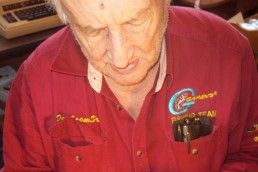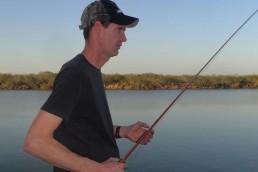SHARE THIS POST
It’s been 82 years since my father, Don Gapen, inventor of the Original Muddler Fly, sat me down at a fly tying vise in our old fly shop at Chalet Bungalow Lodge on the Nipigon River in Ontario. Father would patiently instruct me on how a good artificial fly should be created. However, there is a new creation in town.
In With the New
Within a month or so, I was good enough to see my flies sold at the lodge’s bait shop, where I’d become the lodge’s worm (nightcrawler) guy. Worms were sold by the dozen for ½-cent each. However, it was the fly sales I took pride in. The flies I tied during those cold winter months gladdened my heart and swelled my chest with pride. Each time one of our guests selected one of my flies, I was more than willing to fill them in on how that fly should be fished.
I’d received only ½-cent for tying those creations and they sold for 5 cents each in the fly shop. I became consumed with hawking my work. Unknowingly, this part of my early education was preparing me for a future life as an American manufacturer of fishing tackle.
Two of my proudest moments during those early years came when Charlie Staff of the Prescott Spinner Company of Prescott, Wisconsin, came to me one day and asked if I’d tie for him a special five-feathered Cockatush spinnered fly. The Cockatush, one of Charlie’s creations, was normally tied with only two feathers. Mr. Staff was after a big brook trout in Gapen’s pool on the river—one he’d teased into following his flies but which had failed to strike his offerings.
With the fly tied to Charlie’s instruction, he left the fly shop with my creation. “I’ll be back, son, hopefully with that devil of a fish.” I was eight years old at the time.
You guessed it! Two hours after Mr. Staff left, he was back—with a 7-pound-plus male brookie in hand!
“Gapen, you know what I’m going to do? I’m going to put that five-feathered Cockatush in my line of lures and call it Danny’s Cockatush!” Upon this announcement, Mr. Staff paraded me around the lodge dining room; it was suppertime, telling all the guests who’d listen about the fly, the fish and me. Talk about a swollen chest—I had one! Besides, no one before had ever called me by my last name “Gapen.” That was a sign of manhood!
During the next four days, I was kept busy tying Danny’s Cockatush for an overload of brook trout anglers. And instead of ½-cent each, I received directly from these guests a price of 10 cents to as high as 25 cents per each special fly. I guess that’s called the law of supply and demand.
My other high came when Ted Williams of baseball fame, and Joe Brooks, field editor for Outdoor Life Magazine came to the lodge to fish brook trout. I was to guide Mr. Williams. Dad was to guide Joe Brooks. After day one was over, Ted mentioned to my father that he’d heard about a Danny’s Cockatush fly made by the Prescott Spinner Company. When he found out I was the recipient of the fly’s first name, he asked my father if he’d get me to tie one for him. Of course, I would! And on day two, Ted Williams took a 6 1/2-pound brookie on that very fly.
Up until that time I’d just been a guide—one to paddle the canoe and point to where a trout might be. No more! All conversations with Ted had gone through my father when they pertained to me. Once I netted that trophy brookie, conversations in my canoe proceeded directly from Ted to me and me back to Ted. We became fishing buddies.
The reason for this column will soon come to light. It’s not about the history of the past but about the ethics of the fishing tackle world.
Are you enjoying this post?
You can be among the first to get the latest info on where to go, what to use and how to use it!
A year after Ted Williams and I shared those six days of fishing on the Nipigon River, John Hodak of the Paul Bunyan Bait Company of St. Paul, Minnesota came to fish from our lodge. My father had created an inline spinner bait which he called the NEPAG (Gapen spelled backwards). Gapen’s continue to make this lure, only in an improved model, to this day.
Mr. Hodak was so impressed with the reaction of trout, walleyes and pike that as he was leaving, he asked my father if he’d give the Paul Bunyan Co. permission to make a lure similar to our Nepag in the States. Dad agreed! They shook hands, and that winter the Paul Bunyan Co. came out with the Paul Bunyan 66 lure, which became the forerunner to the Erie Dearie inline spinner. All that was needed in those days was an okay from Dad and a handshake to honor an agreement between tackle manufacturers. Today, all that class, honesty and your word is gone. Send it to China, have it copied and the hell with the handshake.
Now the reason for this column! Recently, Roger Stack of R & R Sports/Fishin Hole Bait Shop on the south side of Milwaukee (actually in Cudahy) sent “Bobber” Anne specs on a new invader shrimp which has taken over the five Great Lakes. Its scientific name is Hemimysis anomala, now called the Great Lakes Bloody Red Shrimp. It seems Gapen’s Freshwater Shrimp comes close to imitating Hemimysis. Roger’s shop’s sales have literally sold thousands of Gapen’s Freshwater Shrimp in 1/32-, 1/16-, 1/8- and 1/4-ounce sizes.
Why all the fuss about Hemimysis? It seems the Great Lakes steelhead love this dude! There appears to be lots of them. A female has an ability to breed from two to four times a year; depending on her size, can produce from 6 to 70 embryos each time.
Where did Hemimysis come from? The best biologists can account for its beginning, “Hemi” came from the Black Sea and the Caspian Sea regions of Southern Europe and sped across Eastern Europe in the 1950s, finally appearing in the British Isles in 2004. Next, “Hemi” did a hitchhike out in the bilges of modern tankers/cargo ships and were flushed into the Great Lakes during the early 2000s.
Hemimysis is here to stay. Anglers are going to have to accept “Hemi” or stop angling the Great Lakes and their entering rivers. Having originated in the backwaters of rivers in the Ponto-Caspian region of Europe, she has adapted well to the similar river waters entering the Great Lakes. Smallmouth bass and possibly river walleyes feed on “Hemi,” so many biologists tell me.
Being a lure manufacturer, with Roger Stack’s help I took it upon myself to attempt to create a clone to Hemimysis. Only one color so far—the Natural—is now being field-tested by Roger’s angling customers. However, if all goes well, other colors will come. Like most crustaceans, this gal is chameleon-like in nature and will take on the habitat colors of their surroundings.
So, readers of MidWest Outdoors—don’t credit Dan Gapen, Sr. for this new creation; give Roger at R & R Sports/Fishin Hole on Milwaukee’s south side the credit for the Hemimysis Anomala recreation’s appearance in our fishing world. I’ll shake Roger’s hand on this one. Ask him about the new Great Lakes Bloody Red Shrimp. Hopefully, we’ll have them available for this fall’s steelhead run; more assuredly for next spring’s run.
Become a MidWest Outdoors Insider here!
MWO
SHARE THIS POST
Did you enjoy this post?
You can be among the first to get the latest info on where to go, what to use and how to use it!
Dan Gapen
Considered one of the world’s leading river anglers, Dan Gapen, Sr. has shared his knowledge with MidWest Outdoors readers and viewers for more than 40 years. He is a member of all three Fishing Halls of Fame—International, National Freshwater, and Minnesota. He has an immense grasp of the world’s fisheries. He may be contacted at 877-623-2099.
@TheGapenCompany.



